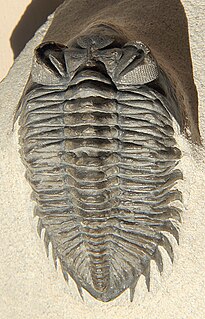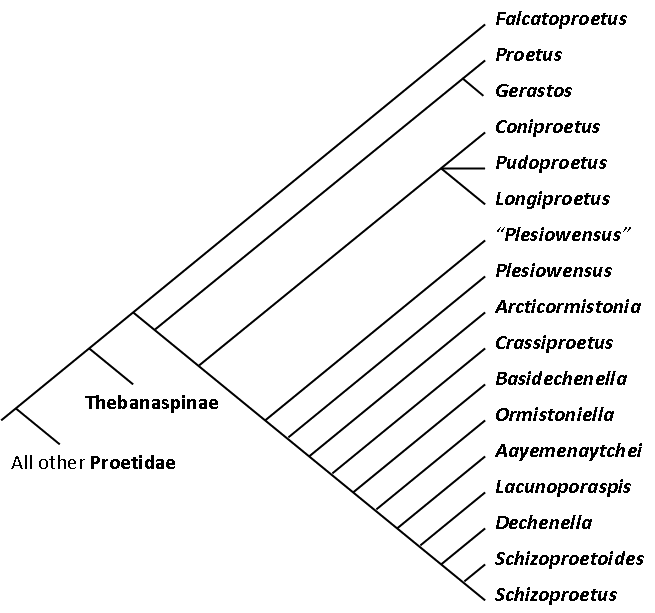
Trilobites are a group of extinct marine artiopodan arthropods that form the class Trilobita. Trilobites form one of the earliest-known groups of arthropods. The first appearance of trilobites in the fossil record defines the base of the Atdabanian stage of the Early Cambrian period, and they flourished throughout the lower Paleozoic before slipping into a long decline, when, during the Devonian, all trilobite orders except the Proetida died out. The last extant trilobites finally disappeared in the mass extinction at the end of the Permian about 252 million years ago. Trilobites were among the most successful of all early animals, existing in oceans for almost 300 million years.

Phacops is a genus of trilobites in the order Phacopida, family Phacopidae, that lived in Europe, northwestern Africa, North and South America and China from the Late Ordovician until the very end of the Devonian, with a broader time range described from the Late Ordovician. It was a rounded animal, with a globose head and large eyes, and probably fed on detritus. Phacops is often found rolled up ("volvation"), a biological defense mechanism that is widespread among smaller trilobites but further perfected in this genus.

Dalmanites is a genus of trilobite in the order Phacopida. They lived from the Late Ordovician to Middle Devonian.

Greenops is a mid-sized Devonian trilobite of the order Phacopida, subfamily Asteropyginae. They are mainly reported from the mid-Devonian Hamilton Group of upstate New York and southwestern Ontario. A similar-looking trilobite from Morocco is often mis-labelled Greenops. Greenops had schizocroidal eyes, large genal spines and short, sharp spines at the tip of each segment of the pygidium ("tail"). Greenops lived in warm, fairly deep water. In the Hamilton Group of New York, they are found with Phacops, Dipleura and Bellacartwrightia, a trilobite that resembles Greenops but has much larger pygidial spines. In Ontario, they are found in the Widder Formation, which outcrops at Arkona, where they are, by far, the dominant trilobite.

Bellacartwrightia is a relatively uncommon genus of Phacopid trilobite, found in the mid-Devonian Hamilton Group of New York state, mainly in strata exposed near Lake Erie just west of Buffalo. This trilobite is usually about 1.5" to 2" long. A very similar trilobite from the Devonian of Morocco is still sold as Metacanthina, but considerable research is still being done on Moroccan trilobites.

Gravicalymene Shirley, 1936, is a genus of trilobites belonging to the order Phacopida, suborder Calymenina and family Calymenidae. Species included in this genus have previously been allocated to Calymene Brongniart 1822,Flexicalymene Shirley, 1936. and Sthenarocalymene Siveter 1977.

Eldredgeops is a genus of trilobites in the order Phacopida, family Phacopidae, known from the late Middle and earliest Upper Devonian of Morocco and the USA.

Acastidae is a family of trilobites in the order Phacopida, suborder Phacopina, superfamily Acastoidea, containing the following genera:

Mummaspis is an extinct genus from a well-known class of fossil marine arthropods, the trilobites, with five known species. It lived during the early part of the Botomian stage, which lasted from approximately 524 to 518.5 million years ago. This faunal stage was part of the Cambrian Period.
Elliptocephala is an extinct genus from a well-known class of fossil marine arthropods, the trilobites. It lived from the later part of the Tommotian to the upper Botomian. Elliptocephala can easily be confused with Ellipsocephalus, a trilobite genus of the Ptychopariida order.

Erbenochile is a genus of spinose phacopid trilobite, of the family Acastidae, found in Lower to Middle Devonian age rocks from Algeria and Morocco. Originally described from an isolated pygidium, the first complete articulated specimen of E. erbeni revealed the presence of extraordinarily tall eyes:
"Straight-sided towers of lenses... with [up to] 18 lenses in a vertical file"

The Devonian Jeffersonville Limestone is a mapped bedrock unit in Indiana and Kentucky. It is highly fossiliferous.

The Biceratopsinae is an extinct subfamily of redlichiid trilobites within the family Biceratopsidae, with species of small to average size. Species belonging to this subfamily lived during the Toyonian stage, 516-513 million years ago, in the former continent of Laurentia, including what are today the South-Western United States and Canada.

Paleontology in Ohio refers to paleontological research occurring within or conducted by people from the U.S. state of Ohio. Ohio is well known for having a great quantity and diversity of fossils preserved in its rocks. The state's fossil record begins early in the Paleozoic era, during the Cambrian period. Ohio was generally covered by seawater from that time on through the rest of the early Paleozoic. Local invertebrates included brachiopods, cephalopods, coral, graptolites, and trilobites. Vertebrates included bony fishes and sharks. The first land plants in the state grew during the Devonian. During the Carboniferous, Ohio became a more terrestrial environment with an increased diversity of plants that formed expansive swampy deltas. Amphibians and reptiles began to inhabit the state at this time, and remained present into the ensuing Permian. A gap in the local rock record spans from this point until the start of the Pleistocene. During the Ice Age, Ohio was home to giant beavers, humans, mammoths, and mastodons. Paleo-Indians collected fossils that were later incorporated into their mounds. Ohio has been the birthplace of many world famous paleontologists, like Charles Schuchert. Many significant fossils curated by museums in Europe and the United States were found in Ohio. Major local fossil discoveries include the 1965 discovery of more than 50,000 Devonian fish fossils in Cuyahoga County. The Ordovician trilobite Isotelus maximus is the Ohio state fossil.

Paleontology in Wisconsin refers to paleontological research occurring within or conducted by people from the U.S. state of Wisconsin. The state has fossils from the Precambrian, much of the Paleozoic, and the later part of the Cenozoic. Most of the Paleozoic rocks are marine in origin. Because of the thick blanket of Pleistocene glacial sediment that covers the rock strata in most of the state, Wisconsin’s fossil record is relatively sparse. In spite of this, certain Wisconsin paleontological occurrences provide exceptional insights concerning the history and diversity of life on Earth.
Bouleia is a genus of trilobites in the order Phacopida which existed during the lower Devonian in what is now Bolivia. It was described by Kozlowski in 1923, and the type species is B. dagincourti, which was originally described under the genus Phacops by Ulrich in 1892. It also contains the species B. sphaericeps, originally described by Kozlowski, also in 1923, as Dereimsia sphaericeps. The type locality was the Icla Formation in Padilla.

Proetus is a genus of proetid trilobite found in Silurian-aged marine strata of Europe.

Coltraneia is a genus of trilobite, that lived during the upper Emsian and lower Eifelian, and has been found in Algeria, France, Germany, Morocco and Spain.

The Milwaukee Formation is a fossil-bearing geological formation of Middle Devonian age in Milwaukee County, Wisconsin. It stands out for the exceptional diversity of its fossil biota. Included are many kinds of marine protists, invertebrates, and fishes, as well as early trees and giant fungi.
Hedstroemia is a genus of trilobites in the order Proetida known from the Silurian period of Europe, Asia, and North America.


















